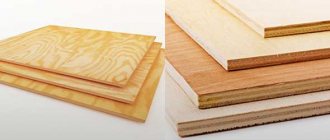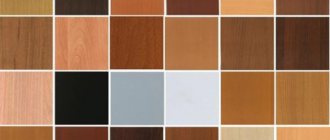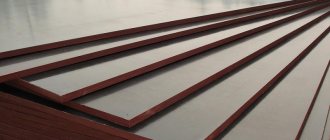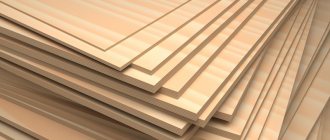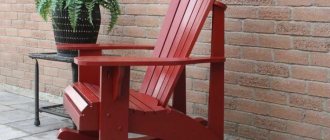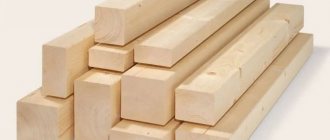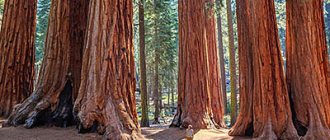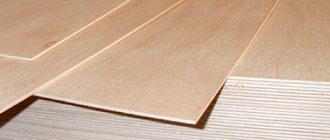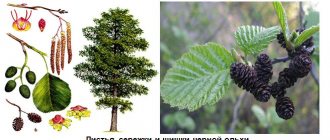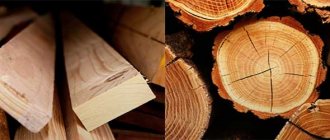GOST also regulates maximum deviations for plywood thickness:
| Nominal plywood thickness, mm | Plywood ply, not less | Sanded plywood | Unsanded plywood | ||
| Maximum deviation, mm | Variation in thickness | Maximum deviation, mm | Variation in thickness | ||
| Plywood 3 mm | 3 | +0,3/-0,4 | 0,6 | +0,4/-0,3 | 0,6 |
| Plywood 4 mm | 3 | +0,3/-0,5 | +0,8/-0,4 | 1,0 | |
| Plywood 6 mm | 5 | +0,4/-0,5 | +0,9/-0,4 | ||
| Plywood 9 mm | 7 | +0,4/-0,6 | +1,0/-0,5 | ||
| Plywood 12 mm | 9 | +0,5/-0,7 | +1,1/-0,6 | ||
| Plywood 15 mm | 11 | +0,6/-0,8 | +1,2/-0,7 | 1,5 | |
| Plywood 18 mm | 13 | +0,7/-0,9 | +1,3/-0,8 | ||
| Plywood 21 mm | 15 | +0,8/-1,0 | +1,4/-0,9 | ||
| Plywood 24 mm | 17 | +0,9/-1,1 | +1,5/-1,0 | ||
| Plywood 27 mm | 19 | +1,0/-1,2 | 1,0 | +1,6/-1,1 | 2,0 |
| Plywood 30 mm | 21 | +1,1/-1,3 | +1,7/-1,2 | ||
As can be seen from the table, the nominal thickness of plywood varies from 3 to 30 mm. However, specialized enterprises produce “aviation plywood” with a thickness of 1 mm or more. This plywood has specialized applications and is regulated by GOST 102-75.
Depending on the brand, the sizes of plywood sheets are divided into:
FSF plywood – 1220x2440, 2500x1250, 3000x1500, 3050x1525.
Types of plywood and its classification
Plywood is a long-known and popular sheet building material. It has high bending strength, both in the longitudinal and transverse directions. In private households it is used for cladding frames and flooring. Cheap varieties are also used in some construction processes.
Plywood is made from several layers of veneer glued together.
Veneer is a wood material that is thin sheets of wood with a thickness of 0.1 to 10 mm.
Fiber layers located in different directions. This increases the flexural strength of the material in all directions.
Plywood is one of the most famous and popular sheet materials in construction.
Plywood is made from coniferous trees and birch. Birch is more expensive and is more often used as furniture. Coniferous is made from wood of all coniferous species. Cheaper options - from larch, pine and spruce - can be used both for the manufacture of furniture and for construction needs (for example, for cladding a frame or for removable formwork in the manufacture of concrete products). Siberian cedar veneer can be used. This type is usually used as a finishing material.
Layers and their number
There are at least three layers in plywood, but there may be more. The layers are arranged so that the veneer fibers are directed in different directions - alternately along the long side of the sheet, then across. An odd number of veneer layers is more common. In private housing construction, three and five-layer plywood are most often used. In this case, the orientation of the layers is selected relative to the central layer.
The location of the layers is perpendicular to each other
If the veneer fibers on the outer layer are directed along the long side, the plywood is called longitudinal. It has great flexibility. If the veneer grains are located along the short side of the sheet, the plywood is called cross-section plywood and is used where high bending rigidity is required.
Moisture resistance
Since glue is used in manufacturing, the entire material has a fairly high degree of water resistance. There are several popular brands of plywood:
- Moisture resistant is marked with FC. For gluing it, glue based on urea-formaldehyde resin is used. That is, there is the emission of formaldehyde. With emission class E1 and lower, it can be used indoors or for making furniture.
- Plywood with increased moisture resistance - FSF. The same glue is used only with water-repellent additives. Can be used for outdoor work.
Some characteristics of popular brands
If you need a material for indoor use and don't want to worry about formaldehyde in the air, look for the FBA brand. It is environmentally safe, but is only suitable for rooms with normal humidity. The FB brand does not swell even under water; there is also BS aircraft plywood. It does not react to chemical environments yet. Used in the construction of ships and airliners.
Surface treatment degree
The outer layers of plywood can be sanded during production. There are these types:
- Unpolished. There is no surface treatment. Marked with NS.
- Only one side is sanded smooth. Ш1 is added to the marking.
- Both sides are sanded - Ш2.
Extra class or first grade plywood can be sent for grinding
Plywood sanded on both sides is used to make furniture. For construction, both smooth sides are rarely needed. Usually, if polished is used, then Ш1. And only if this material is used for decorative cladding. More often on construction sites you need unsanded one - it provides better adhesion to other materials.
Varieties and labeling
There are five grades of plywood. The highest is E (Elite), and then, as it gets worse, from I to IV. The grade is determined by the condition of the upper - front layers. Moreover, the quality of both surfaces is assessed separately and written through a slash. For example, I/II or III/IV.
GOST describes in detail what surface errors are permissible for which grade; there are special tables by which this grade is determined. If at least one parameter is worse than acceptable, the grade is reduced.
Varieties differ in the presence and size of certain defects
Here are the features on the front surface that different types of plywood may have.
- Elite For this brand of plywood, the veneer must be perfect. There may only be minor changes to the wood (no eyes). All. There should be no other shortcomings.
Grade E (Elite) must not have any defects
Only minor features are acceptable in small quantities
There are already more serious defects here
The difference in knots and their type
Significant changes in color, numerous knots and other surface imperfections
Chips, scratches and dents are still acceptable here, which are only limited by thickness tolerances (usually 0.5 mm)
Correspondence of plywood grade designations according to various standards: GOST 3916.1-96, TU 5512-002-00255214-2000, GOST 10.55-71
If there are defects not listed in GOST, the product is considered substandard. It is also considered substandard if the maximum permissible size of defects is exceeded. Sometimes they try to sell such products as a fourth grade, but this is a re-grade and the price for it should be significantly lower.
By the way, if there are no obvious cracks or fallen knots, the third grade can be used for interior finishing. In certain interiors it looks even more interesting than E or the first, which are simply a flat sheet without any features inherent in wood.
Plywood: sheet dimensions, thickness
For different jobs, sheet material of different sizes may be more convenient. And plywood is no exception. It is available in different sizes, which are usually divided into standard and non-standard. Standard ones are prescribed in GOST standards (GOST 3916.1-96), non-standard ones are produced to order - for large companies or those formats that are more in demand in retail. Usually a sheet of plywood has the shape of a rectangle, but it can also be in the shape of a square.
There are rectangular and square plywood sheets
Standard plywood sizes
In general, different types of plywood are described by different GOSTs (GOST 2707, GOST 20907, GOST 102-75, GOST 3916.1-96) and they contain different size grids.
Standard sizes may vary depending on regulations
The most popular small-format plywood sheets have the following standard sizes:
Small sheets of plywood are good because you can work with them without helpers. But a large number of seams is not good.
According to GOST 3916.1-96, it is allowed to produce plywood of non-standard length by agreement between the manufacturer and the consumer.
Plywood dimensions according to GOST 3916.1-96
In theory, combinations from the above list can be any. In practice there are much fewer of them.
Large format
In some cases, it is more convenient to use large sheets of plywood - there are significantly fewer joints. The most commonly used large format plywood is the following sizes:
- 1830*1525 mm;
- 3050*1525 mm
- 3000*1500 mm;
- 2500*1250 mm;
- 2440*1220 mm.
Plywood: dimensions and thickness are standardized by a large number of standards
No one has brought order to the standards, so theoretically you can find almost any size that fits into one of them. So, for example, according to GOST 102-75:
- The length of the plywood sheet can be from 1000 mm to 1525 mm. The length change step is 25 mm.
- The width can be from 800 mm to 1525 mm with the same gradation pitch - 25 mm.
Moreover, the maximum deviation in length and width is 4 mm. The thickness of the plywood can be from 1 mm, but this is a rare “aviation” grade. The usual one is available in thicknesses from 3 mm to 30 mm, but you can find up to 40 mm. The permissible error in thickness dimensions is 0.5 mm.
There are standards regulating the sizes of coniferous and hardwood plywood
If you look at the later standard 3916.1-96, it specifies a different grid of plywood sizes with a specific listing of possible values (see table above).
Thickness
The picture with the thickness of plywood is approximately the same: if desired, you can find from 1 mm to 40 mm thick. It is possible that there are thicker options. But most often there are slabs with a thickness from 6 mm to 27 mm.
Thickness of hardwood and softwood plywood, ply layers and permissible deviations for sanded and unsanded boards
By the way, it’s interesting that any of the standards states the maximum permissible deviation is 0.5 mm. Which, considering the number is not always large, is not so little. And this deviation can significantly complicate the installation of the material on the floor. The difference has to be corrected with thin pads, or, if it is small, sanded off at the joints with a sanding machine.
Thickness
The most important characteristic is the thickness of the plywood sheet. For interior decoration, panels with a thickness of 2-10 mm are taken. They are used, for example, as wall coverings. Plywood is also used for flooring. And when making a waterproof floor, a sheet thickness of 8-10 mm is used. With unevenness, the thickness increases, as a rule, to 12.
Below are approximate tables of volume, weight, dimensions
| Birch plywood sheet thickness (mm) | birch sheet , weight of cube and square meter | |||||||
| 1220 x 2440 mm | 1525 x 1525 mm | |||||||
| Number of sheets in 1m3 | Weight of 1 sheet (kg) | Weight 1 m3 (kg) | Weight 1 m2 (kg) | Number of sheets in 1m3 | Weight of 1 sheet (kg) | Weight 1 m3 (kg) | Weight 1 m2 (kg) | |
| 3 | 112 | 5,8 | 650 | 1,9 | 143,3 | 4,5 | 645 | 1,9 |
| 4 | 84 | 7,7 | 647 | 2,6 | 107,5 | 6,1 | 656 | 2,6 |
| 5 | 67,2 | 9,7 | 652 | 3,3 | 86 | 7,6 | 654 | 3,3 |
| 6 | 56 | 11,6 | 650 | 3,9 | 71,7 | 9,1 | 652 | 3,9 |
| 6,5 | 51,7 | 12,6 | 651 | 4,2 | 66,2 | 9,8 | 649 | 4,2 |
| 7 | 48 | 13,5 | 648 | 4,5 | 61,4 | 10,6 | 651 | 4,5 |
| 8 | 42 | 15,5 | 651 | 5,2 | 53,8 | 12,1 | 651 | 5,2 |
| 9 | 37,3 | 17,4 | 649 | 5,8 | 47,8 | 13,6 | 650 | 5,2 |
| 10 | 33,6 | 19,4 | 652 | 6,5 | 43 | 15,1 | 649 | 6,5 |
| 12 | 28 | 23,2 | 650 | 7,8 | 35,8 | 18,1 | 648 | 7,8 |
| 15 | 22,4 | 29 | 651 | 9,7 | 28,7 | 22,7 | 651 | 9,8 |
| 18 | 18,7 | 34,8 | 650 | 11,7 | 23,9 | 27,2 | 650 | 11,7 |
| 20 | 16,8 | 38,7 | 650 | 13 | 21,5 | 30,2 | 649 | 13 |
| 21 | 16 | 40,6 | 650 | 14,6 | 20,5 | 31,7 | 650 | 13,6 |
| 24 | 14 | 46,4 | 650 | 15,6 | 17,9 | 36,3 | 650 | 15,6 |
| 27 | 12,4 | 52,3 | 649 | 17,6 | 15,9 | 4,8 | 649 | 17,5 |
| 30 | 11,2 | 58 | 650 | 19,5 | 14,3 | 45,4 | 649 | 19,5 |
| thickness, mm | Parameters of a sheet of coniferous plywood, weight of a cube and square meter | |||||||
| 2500x1250 mm | 2440x1220mm | |||||||
| PC. in m³ | sheet weight, kg | weight m³, kg | weight m², kg | sheets m³ | sheet weight, kg | weight m³, kg | weight m², kg | |
| 6 | 53,3 | 10,3 | 549 | 3.3 | 56 | 9,8 | 549 | 3.3 |
| 6,5 | 49,2 | 11,2 | 551 | 3.6 | 51,7 | 10,6 | 548 | 3.6 |
| 8 | 40 | 13,8 | 552 | 4.4 | 42 | 13,1 | 550 | 4.4 |
| 9 | 35,6 | 15,5 | 552 | 5 | 37,3 | 14,7 | 548 | 4.9 |
| 9,5 | 33,7 | 16,3 | 549 | 5.2 | 35,4 | 15,6 | 552 | 5.2 |
| 12 | 26,7 | 20,6 | 550 | 6.6 | 28 | 19,7 | 552 | 6.6 |
| 12,5 | 25,6 | 21,5 | 550 | 6.9 | 26,9 | 20,5 | 551 | 6.9 |
| 15 | 21,3 | 25,8 | 550 | 8.3 | 22,4 | 24,6 | 551 | 8.3 |
| 16 | 20 | 27,5 | 550 | 8.8 | 21 | 26,2 | 550 | 8.8 |
| 18 | 17,8 | 30,9 | 550 | 9.9 | 18,7 | 29,5 | 552 | 9.9 |
| 19 | 16,8 | 32,7 | 549 | 10.5 | 17,7 | 31,1 | 550 | 10.4 |
| 21 | 15,2 | 36,1 | 549 | 11.6 | 16 | 34,4 | 550 | 11.6 |
| 24 | 13,3 | 41,3 | 549 | 13.2 | 14 | 39,3 | 550 | 13.2 |
| 27 | 11,9 | 46,4 | 552 | 14.8 | 12,4 | 44,2 | 548 | 14.8 |
general information
In general, the production of laminated plywood is not much different - logs are processed into veneer, followed by the application of glue, laying and pressing. But the next step is lamination - the creation of a special film.
The latter is made of thick paper impregnated with a mixture of phenolic and melamine-formaldehyde resins. Laminating film has the following features:
- moisture resistance;
- wear resistance;
- strength, density;
- antiseptic properties.
The laminating film is placed on both sides of the plywood sheet. In this case, acrylic paint is applied to the ends. It improves moisture-resistant characteristics.
After such processing, laminated plywood also acquires the following properties:
- high strength, reduced likelihood of material delamination;
- resistance to strong temperature changes;
- immunity to bacteria, rotting;
- resistance to chemical reagents.
The building material also has some disadvantages. First of all, this is a decrease in environmental friendliness due to impregnation of the film with glue. In addition, laminated plywood is more expensive than other types of materials.
Important! If you are sawing a sheet of plywood, do not forget to treat the cuts with a special compound. Otherwise, the resistance of the material to moisture will be significantly reduced.
Characteristics that determine weight
To produce plywood, veneers from several tree species are used, differing in the production methods. The texture, specific gravity, natural humidity and moisture resistance of wood affect the characteristics of veneer, the weight of which may vary. The thickness of the veneer layer also varies from one type of product to another. Therefore, it is impossible to say in advance how much plywood weighs without taking into account the specifics of its structure.
The weight of a sheet of plywood is most affected by:
- type of wood (the specific gravity of birch material is greater than coniferous);
- thickness;
- square.
To glue layers and fix the laminated coating (if present), various types of adhesives are used, including phenol-formaldehyde, bakelite, casein, melamine and others.
Despite the differences in the structure and composition of adhesives, none of them fundamentally affects the weight of plywood. The method of finishing the surface and the quality of the coating that can be applied to it are of minor importance. Even lamination, which provides the most reliable waterproof protection of FSF or FSK plates from external influences, does not noticeably change the weight of the plywood, because the polymer film has a very small mass.
Elite goods are uniform in structure and density, unlike low-grade products, so the weight depends slightly on the grade.
Technical specifications
In the production of laminated plywood, FSF boards are used. To glue veneer together, phenol-formaldehyde resins are used, which do not dissolve when exposed to liquid and increase moisture resistance. After this treatment, the material has the following characteristics:
| Property | Index |
| Emission | E1 |
| Density level | 640-700 kg/m3 |
| Tensile strength | 40 MPa |
| Bending strength | 60 MPa |
| Moisture level | To 10% |
This confirms that laminated plywood is resistant to moisture and is highly durable. This makes the material very durable and multifunctional.
Laminated plywood is divided into several types depending on the following parameters:
- type of wood for veneer production;
- sheet thickness and size;
- surface type.
Next, we will consider all these types of laminated plywood in more detail.
Operational purpose
Depending on the purpose for which such a board is intended, the following types can be distinguished:
- General purpose material;
- Building;
- Furniture;
- Decorative;
- Bakelized;
- Aviation;
- Plywood boards;
- Laminated.
Universal material or general purpose plywood
A universal product
This layered wood product consists of three or more layers of peeled veneer, tightly glued together. When creating such a layered board, the veneer layers are positioned so that the position of the fibers of any sheet is absolutely perpendicular to the direction of the fibers of the previous layer. Larch and coniferous wood can be used to make layers.
Note! Plywood is considered to be made from the type of wood that was used to create the outer layers of veneer.
The instructions for use indicate that this is a general purpose material.
The properties of such layered boards are stipulated by the following regulatory documents:
- GOST 3916.1-96 for deciduous trees;
- GOST 3916.2-96 for coniferous species.
Also, the properties are greatly influenced by the glue used during creation.
Depending on the type of glue, the board can be moisture resistant with varying degrees of resistance to moisture:
- FSF – plywood with increased moisture resistance characteristics, made using formaldehyde adhesives;
- FC is waterproof plywood, for the manufacture of which urea-formaldehyde adhesives are used.
The designation of such boards is carried out in accordance with the type of veneer used for the front and back covering. First of all, indicate the type of wood of the front layer of the product, and secondly, the back layer. The type of wood may also be included in the designation.
So, for example, the letter “x” indicates the use of wood from trees belonging to the coniferous group. There is also a designation for the degree of machining performed.
You may encounter this designation:
- NS – unpolished;
- Ш1 – one-sided grinding;
- Ш2 – double-sided grinding.
Table No. 1 Main parameters of NS birch material with sheet size 1525x1525 mm
| Thickness (mm) | Weight of one sheet (kg) | Number of sheets per package (pcs) | Pack volume (m3) |
| 3 | 4,6 | 130 | 143,3 |
| 4 | 6,2 | 100 | 107,5 |
| 5 | 7,7 | 80 | 86,0 |
| 6 | 9,3 | 65 | 71,7 |
| 8 | 12,4 | 50 | 53,8 |
| 9 | 14 | 44 | 47,8 |
| 10 | 15,5 | 40 | 43,0 |
| 12 | 18,6 | 33 | 35,8 |
| 15 | 23,2 | 26 | 28,7 |
Construction material
In the photo - a product applicable for construction work
This is the term used when talking about plywood, which is intended for construction work as a basis for creating certain structures, such as floors, ceilings, partitions, etc., as well as in the process house building as formwork.
This area of application is also determined by the fact that this type of plywood does not have any special requirements for the quality of the surface of the sheets, much less for sanding. This type of product is classified as grades III and IV.
In addition, the construction type of product of this kind is sheets of large thickness. So, for example, for the construction of high-quality formwork, the boards must be 1.8-2 cm thick.
To make such plywood, thick veneer is used with sheets about 2 mm thick, using coniferous wood or a combination of veneers from various trees. The price of such a material is low, but it has all the necessary physical and mechanical properties.
Note! Laminated plywood can also be classified in this group of building materials due to the fact that it is used in the process of monolithic construction as reusable formwork. The main characteristics of such material are given in Table No. 2
Table No. 2 - Some indicators of grade 1 laminated plywood
| Sheet width(mm) | Sheet length(mm) | Cast thickness(mm) | Sheet volume(m3) | Sheet weight(kg) |
| 1220 | 2440 | 18 | 18,66 | 29 |
| 1220 | 22440 | 21 | 16 | 33 |
The density of this type is 700 kg/m3
Furniture plywood
The basis for creating furniture
High demands are placed on such a construction basis, especially for such parameters as:
- Surface quality, absence of defects and thorough grinding;
- The ability of the product to retain its shape;
- Quality of the gluing procedure.
Plywood sheets belonging to this group are also used as decorative finishing.
Bakelized material
Glued layer of birch veneer
This type of laminated board is made using birch veneer sheets and phenol-formaldehyde adhesive mass with the addition of resins. The production process is carried out under high pressure conditions, which determines the fact that the material is distinguished by high density + plywood retains its shape well.
Note! The strength indicator of this product is 1200 kg/m3. This board does not sink in water.
Table No. 3 - Main parameters of FBV 2440x1220 (mm)
| Thickness (mm) | Weight of one sheet (kg) | Number of sheets per package (pcs) | Package volume(m3) |
| 7 | 25 | 85 | 1,21 |
| 10 | 36 | 40 | 119 |
| 12 | 43 | 34 | 1,21 |
| 15 | 55 | 27 | 1,20 |
| 18 | 64 | 22 | 1,18 |
The density of this type is 1.4 MPa
Aviation birch plywood
Thin sheet
Aviation requires raw materials that, despite their thin thickness, maintain a high level of strength. That is why for the manufacture of aircraft plywood, birch wood veneer is used, which is glued together using phenolic adhesives with the addition of bakelite films.
Such a thin material has found its application in the manufacture of light-weight aircraft, both at the production level and with your own hands, sound production instruments, etc.
Table No. 4 - Tensile strength of aviation material of different brands
| Thickness(mm) | Strength limit (Mpa) | ||||
| When stretched along the fiber | When folding | ||||
| BP-A; BS-1 | BP-V; BPS-1V | BP-V | |||
| 1st grade | 2nd grade | 1st grade | 2nd grade | ||
| 1 | 95,5 | 81,0 | 93,0 | 81,0 | — |
| 1,5-2 | 95,5 | 81,0 | 93,0 | 81,0 | 2,35 |
| 2,5 | 92,0 | 79,0 | 90,5 | 79,0 | 2,35 |
| 3-4 | 85,0 | 71,0 | 83,5 | 71,0 | 2,35 |
| 5 | 78,5 | 66,0 | 76,0 | 66,0 | 2,45 |
Plywood boards
Joiner's laminated board
This material consists of 7 or more veneer layers, which are glued together with synthetic adhesives. This type of plywood has found its use in agriculture, the construction of sports equipment and the creation of other structures that require special raw materials that bend well in one direction.
By type of wood
Conventionally, laminated plywood is divided into two types, taking into account the type of wood from which the veneer is made:
- Made from hardwood. Birch is most often used. This veneer is thinner, but has a high degree of strength and hardness, for which it is highly valued. As a rule, sheets of laminated birch veneer plywood have dimensions of 1500x3000 mm.
- From coniferous species. It has a more affordable price, but also yields some technical characteristics in favor of the previous type. Coniferous veneer has less strength and is softer. However, due to the high resin content in the wood structure, the moisture-resistant characteristics of the material increase. Sheets of laminated softwood plywood often have parameters of 1220x2440 mm.
Kinds
Laminated plywood differs in the following parameters:
- sheet size and thickness;
- surface type;
- wood from which the veneer is made.
Below we will take a closer look at all types of this material.
Plywood sheets 1220x2440 mm
Dimensions
The dimensions of laminated plywood and its thickness may vary, however, they are within the following limits:
| Options | Meaning |
| Length | 244 – 300 cm |
| Width | 120-150 cm |
| Thickness | 9-40 mm |
| Weight | from 18 to 80 kg/sheet |
Moisture-resistant laminated plywood 27 mm
Note! Correctly selected sheet dimensions will not only allow you to use them with a minimum amount of waste, but also speed up cutting work.
It should be noted that the thickness of laminated plywood is one of the most important parameters, since the following properties of the material depend on it:
- strength;
- flexibility;
- resistance to mechanical loads;
- weight.
In addition, the price of the sheets depends on the thickness. Thus, 9 mm laminated plywood costs significantly less than, for example, similar 30 mm thick boards.
Advice! To find out how much laminated plywood weighs, you should consult the reference literature. In this case, it is necessary to know the dimensions and thickness of the sheet.
Options for laminated sheet surfaces
Surface type
According to GOST for laminated plywood No. 53920-2010, the film on its surface can be formed by the following chemicals:
- phenol is a resin made on the basis of formaldehyde and phenol;
- melamine - this substance is formed by pressed melamine-formaldehyde resins;
- PVC is a transparent or opaque polyvinyl chloride film of low toxicity.
In addition, depending on the texture, the surface of the sheets can be of the following types:
- SP – for painting (there are special instructions for painting a laminated surface);
- F – smooth;
- W – embossed (mesh).
Plates with embossed surface
Wood type
Depending on the type of wood from which the veneer is made, the material can be divided into two types:
- softwood veneer plywood is a cheaper option. The disadvantages of wood include softness, but such veneer itself is resistant to moisture due to the high resin content in the structure. The standard sheet size of laminated softwood plywood is 1220-2440 mm;
- from hardwood veneer - as a rule, hardwood means birch. This type of plywood is most valued due to its hardness and strength; in addition, the thickness of birch veneer is less than coniferous. The standard size of such sheets is 1500×3000 mm.
Manufacturer country
Recently, it has become the case that the properties of a material also depend on the country of origin.
The following plywood can most often be found on the market:
- Finnish - is the most expensive, but at the same time the most durable. When used in construction, this material can withstand more than a hundred freezing cycles;
- Russian - as a rule, made of birch. During its manufacturing process, all quality standards are observed. However, in some characteristics it is inferior to the Finnish one, in particular, it can withstand only 60 freezing/defrosting cycles;
- Chinese - wood veneer of various species can be used as a material for it, such as poplar, alder, eucalyptus, etc. This plywood is the least durable, in addition, it usually has a high formaldehyde content. Its only advantage is its low cost.
Here, in fact, are all the types of laminated plywood that can be found on sale recently.
Truck bodies covered with laminated plywood
Dimensions
Laminated plywood sheets are divided into different types depending on their size and thickness. Parameters can change in the following range:
- width – from 120 to 150 mm;
- length – within 2440-3000 mm;
- sheet thickness – from 9 to 40 mm;
- weight – 18-80 kg.
Remember! It is important to choose the correct sheet size that is needed for a specific purpose. This way you will reduce the cutting time and minimize the amount of waste, and this is already a good money saving.
It is very important to correctly determine the required thickness of laminated plywood. This parameter affects the following performance properties:
- flexibility;
- strength level;
- weight;
- resistance to mechanical stress.
Moreover, the thickness of the sheet also affects the pricing policy of laminated plywood: the thicker it is, the more expensive the material will be.
Healthy! To determine the weight of plywood, you need to know the thickness and size of the sheet, and compare this data using special reference literature.
How to calculate weight
Many professional and private builders are faced with the need to calculate the weight of a plywood sheet. Calculating the mass of the slab is not difficult, you just need to know the basic information about the wood material, namely:
- sheet size;
- product thickness;
- number of slabs in the package;
- pack weight.
Having the above data, you can begin to calculate the mass of the plywood sheet.
The first step of the calculations is to calculate the total cubic capacity of the pack, which is done by multiplying the length, width, thickness and number of slabs in the package. It is important to remember that before starting computational operations, it is necessary to convert all units of measurement into a single unit - the meter.
The second stage is calculating the density of the wood material. This value is determined by dividing the mass of the pack by the previously calculated volume.
It is important to note that this calculation is acceptable only when calculating the weight of slabs of the FK and FSF grades. If it is necessary to calculate the weight of other brands of plywood (low/high density), it is recommended to seek help from professionals.
Types of laminated plywood depending on the surface
GOST No. 53920-2010 strictly defines which chemicals can be used to treat special film covering plywood sheets:
- melamine - formed by pressing melamine-formaldehyde smog;
- phenol - a resin containing a mixture of phenols and formaldehyde;
- PVC is a polyvinyl chloride film with a low level of toxicity; its appearance can be colored or transparent.
The surface of laminated plywood also differs in its texture:
- F – completely smooth;
- SP – produced for subsequent painting (such work is carried out according to special instructions);
- W – mesh (embossed) surface.
Producing countries
In practice, it was noticed that the technical properties of laminated plywood are largely determined by the country of origin. Today you can most often find the following types of materials:
- Russian. It is made mainly from birch wood and implies compliance with all GOST requirements. This is a fairly high-quality material, but it is still inferior in technical properties to Finnish plywood. For example, Russian-made sheets can withstand no more than 60 defrosting and freezing cycles.
- Chinese. It is characterized by low cost, but the quality indicators of the material are at the same level. The veneer for such plywood is made from a mixture of different types of wood - alder, poplar, eucalyptus, etc. Such sheets are not very durable, and the material often contains high levels of formaldehyde.
- Finnish. This is the most expensive and at the same time the highest quality laminated plywood. The sheets are highly durable and can easily withstand more than 100 stages of freezing and thawing.
The listed types of laminated plywood can most often be found on the construction market.
Large plywood producers in Russia
There are 30 factories located on the territory of the Russian Federation that successfully produce various brands of plywood. They are guided by developments produced by the world's only Plywood Research Institute.
The most successful manufacturers of competitive products are the following:
- Vyatsky plywood mill.
- Nizhny Novgorod LLC "Zavetluzhye".
- Sveza group.
- Irkutsk "Usolsky Plywood Mill".
- Obninsk plywood mill, located in the Kaluga region.
- Arkhangelsk plywood plant.
- Syktyvkar plywood plant in the Nizhny Novgorod region.
The first three enterprises from this list are leaders not only in terms of the volume of products produced, but also in their quality.
Areas of application
Where is laminated plywood used? Thanks to its many useful characteristics, the material has a fairly wide range of applications. Laminated plywood is most in demand in the following areas:
- Construction. Sheets of laminated plywood are actively used in the arrangement of warehouses, formwork and other structures. Since the material is available in a variety of colors and has a rather aesthetic appearance, it has recently begun to be used for interior decoration of houses.
- Arrangement of children's and sports grounds.
- Shipbuilding and engineering industry. Laminated plywood is widely used for the improvement of floors in public transport, trucks, and ship decks, as it has a high level of strength and at the same time has a relatively low weight. Sometimes sheets are also used for finishing vehicles, in particular for body cladding.
- Advertising designs. Stands, billboards, etc. are often made from laminated plywood.
This is only a small part of the areas in which laminated plywood can be used. In addition, it will certainly come in handy in a suburban area, because you can make multiple household appliances from it.
Important! When making structural holes, do not forget to cover them with moisture-resistant material (paint). This way you will increase the durability of the material and will not compromise its moisture-resistant characteristics.
Laminated plywood is of high quality and has important technical properties, in particular, a high level of moisture resistance and strength. This makes it in demand when performing outdoor work. On the market you can find a variety of types of material, differing in aesthetic characteristics, size, thickness, wood veneer. When choosing, you should pay attention to each of these parameters in order to select the laminated plywood that is most suitable for the implementation of your tasks.
Dimensions and characteristics of laminated plywood
Laminated plywood is one of the most popular materials on the construction market. It is made by processing wood using peeling machines. At the end of the technological process, the surface of the plywood sheet is covered with a special film, which provides this material with a whole range of useful properties:
Laminated plywood is an inexpensive and high-quality material with high moisture resistance.
- increased moisture protection;
- exceptional wear resistance;
- frost resistance;
- inertness to many chemicals.
Types and varieties
If you decide to purchase plywood for certain purposes, you should know its main types and grades. Depending on the purpose, the top layer of the sheet can be processed:
- phenol – resin based on phenol and formaldehyde;
- melamine - a substance that consists of pressed melamine-formaldehyde resins;
- PVC – transparent or opaque film with a low toxicity level.
Depending on the front surface, laminated plywood is classified into the following grades:
Dimensions of plywood sheets.
- Grade B. The surface of the sheet is coated with a special varnish or other dye. The wood may have slight inhomogeneities, that is, knots up to 1 cm in size may occur on the surface. The number of such elements should not exceed 10% of the total sheet area.
- Variety BB. The material can be covered with knots up to 2 cm in size in an amount of no more than 25% of the total area. This plywood may contain small cracks.
- Variety SR. The surface of the material is treated with paint or film coating. The sheet may contain knots with a diameter of more than 2 cm and cracks up to 1.5 mm wide.
- Grade C. Differs in low cost. The surface is covered with film or paint. The presence of fused or unfused knots of any size and in any quantity, as well as cracks and other coating defects, is allowed.
Production Features
Description of the technology for manufacturing sheet products:
- Mostly birch wood is chosen for work. The use of coniferous species is allowed, but only for the core. The raw materials undergo standard preparation and peeling on a special machine.
- The veneer is sent for discarding. To glue the layers, a mixture based on phenol-formaldehyde resins is used.
- Pressing is carried out under pressure and temperature.
- The slabs are given a format and the surfaces are polished.
- The panels are laminated with a film of the desired color, the most popular being white and black. To ensure a secure fit, the surface is exposed to thermal effects.
- The edges are processed.
Laminated boards cannot be made using homemade equipment; this process involves multi-stage impregnation and processing of the material, this actually explains the high price of the product.
If low-quality raw materials were used or the technology was violated, the product will not meet the declared characteristics.
On a note! The manufacturer must indicate the norm or standard on the basis of which the plywood was manufactured.
Specifications
The main characteristics of this material are:
- sheet thickness: from 9 to 40 mm;
- standard sheet sizes: 120x240, 125x250, 244x122, 250x125 cm;
- density: 680-700 kg/m3;
- humidity: less than 10%;
- texture of the top layer: SP – paper, W – mesh, F – smooth.
The strength characteristics of the laminated sheet are presented in the table.
| Name of parameters | Value, MPa |
| Maximum chipping strength on the adhesive layer after soaking for 24 hours | 1,5 |
| Maximum tensile strength | 40 |
| Maximum static bending strength | 60 |
Properly selected dimensions of the material will allow you to use it with a minimum amount of waste and cutting work, which can take quite a lot of time . Particular attention must be paid to the choice of thickness, since many operational characteristics of plywood depend on it: strength, resistance to mechanical loads, etc.
Sheets up to 25 mm thick are used in the manufacture of cabinet furniture. Thicker material is used in finishing work, in the construction of upholstered furniture and various building elements.
